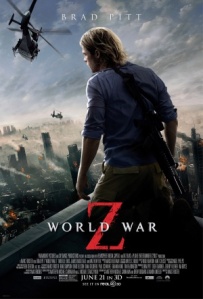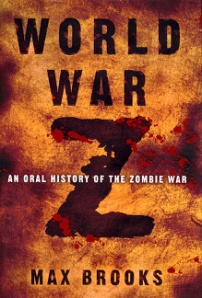Their presence in fiction mirrors the reality in which we reside; a reality that reflects the fact that zombies are everywhere. In fiction they’re a world wide threat bent on nothing in particular except eating people. In reality we just have an over saturated amount of TV shows, books, comic books and concept art that caters our cultures insatiable and weird appetite for these cannibalistic corpses. I’m part of the problem too, I love a good zombie movie and can appreciate the moral and logistical quandaries that they present to those attempting to survive in their world. World War Z is the best zombie story I have ever consumed. Let me be clear, I am currently talking about the novel by Max Brooks in which an unnamed (and certainly not Brad Pitt) UN worker travels around the world AFTER the big Zombie war interviewing survivors. Like anything that becomes remotely popular it demanded a cinematic representation! And so we got a film with the same title….and that’s about it.
World War Z (film) stars Brad Pitt as a UN worker by the name of Gerry Lane whose task it is to finds himself thrust into the center of a massive scale zombie epidemic. He is tasked with finding the origin of the disease with the hope of figuring out just what can be done to stop the spread of the infection. This takes him all around the world, where he observes a few different temporary solutions that various cultures have enacted to help protect themselves…all of which end up failing. It’s a sort of follow-the-bread-crumbs adventure in which Brad Pitt straps magazines to his forearms as a type of makeshift armor to prevent being bit. Honestly that was my favorite part.
World War Z (novel) is narrated by an unnamed UN worker that is tasked with traveling around the world to interview survivors of the zombie war. The novel starts out with the war being over. Humanity won the fight against the zombie threat, but just barely. Each chapter is an oral report of how a different culture or people group witnessed and consequently survived their particular encounter. The accounts range from a colony yuppie campers attempting to flee north in their caravan of luxury motorhomes to a Japanese teenage gamer who must figure out a way to escape from his skyscraper home. Major battles are discussed in great detail and the entire course of the fight is laid out in different styles and flavors for the reader to savor.
Brad Pitt’s starring vehicle hovered around the 200 million dollar mark to make. It was ok. It was an honest to goodness zombie fest in which millions of zombies ran very quickly towards the protagonist at almost every turn. The film managed to gloss over the intricate details laid out in the novel and replace them with faster enemies and bigger explosions. It was a visual effects feast that practically begged you to just switch off the part of your mind that yearns for a plot within a story. Sure there was a goal Gerry was trying to attain, and it had to be done quickly, but it is nestled safely under an enumerable amount of human corpses. It had it’s merits, and while the large scale attacks were impressive to look at, they had little effect on my emotional reaction to the film. It was the tight, claustrophobic scenes that amped up the suspense.
The Novel offered a large series of individual stories that, when combined painted a picture of the full scale that the fictional zombie plague had on a vast number of cultures and individuals. Each account has it’s own protagonist and their own setting. Some read like a pulp adventure novel while others are absolutely chilling in their dissection of human nature. While the zombie threat is ever present and the main focus of the novel, it isn’t the sole enemy. Some accounts take into account the psychological damage associated with seeing your loved ones turned into monsters, it looks at the depravity of humanity, at times allowing for very little room to distinguish between the real horrors of humanity and the fictional horror of the zombies. Unlike the film, the book uses the traditional “slow zombies” and manages to make them terrifying. The narrator of the book takes a back seat to the survivors, the everyday people that did what it took to survive.
The World War Z novel was so good it ought to have it’s own movie. As it stands it does not have that. Aside from a few, almost coincidental similarities, the novel and film that share a name are worlds apart (within the scope of the zombie genre). Where the film was your run-of-the-mill action film with a massive budget, the novel presents you with a great number of individual stories, each interesting and unique, but working together to form the most compelling Zombie story I’ve ever experienced.

